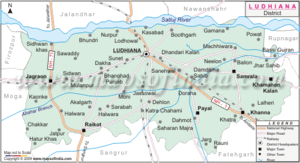Raikot

Raikot (राय कोट) (Rai Kot ) is a city and tahsil in Ludhiana district in the Indian state of Punjab.
Contents
Jat Gotras
Villages in Raikot Tahsil
Abuwal, Acharwal, Aitiana, Akalgarh, Akalgarh (CT), Andlu, Badhel, Baraich, Barhampur, Barmi, Barundi, Basraon, Bassian, Bhaini Baringan, Bhaini Darera, Bhaini Rora, Binjal, Boparai Khurd, Burj Hakiman, Burj Hari Singh, Burj Littan, Burj Naklian, Chak Bhai Ka, Dadahur, Dangon, Dhalian, Dhurkot, Ghuman, Gobindgarh, Gondwal, Halwara, Heran, Hisowal, Jalaldiwal, Jand, Jatpura, Jhorran, Johlan, Kaila, Kalsan, Kalsian, Kishangarh, Leel, Littar, Lohat Badi, Maherna Kalan, Mohamadpura, Nangal Kalan, Nangal Khurd, Nathowal, Nurpur , Pakhowal, Pheru Raien, Rachhin, Raikot (M Cl), Rajgarh, Rajgarh, Rajoana Kalan, Rajoana Khurd, Ramgarh Sibian, Rattowal, Ruppa Patti, Sakhana, Sattowal, Shahidgarh, Shahjahanpur, Shahpur, Shehbazpura, Siloani, Sudhar, Tajpur, Talwandi Rai, Toosa, Tugal, Tungaheri, Umarpura,
History
Raikot was founded by Rai Ahmad in 1648. Rai Kalha III, the chief of Raikot had the honour of extending seva and hospitality to Guru Gobind Singh ji in 1705(Aurangzeb raj), at the risk of losing everything including his life and that of his family. Guru sahib ,in appreciation and gratitude gave Ganga Sagar, a sword and a wooden rehel(used for reading religious scriptures) to Rai Kalha as personal gifts for his brave and courageous act.Rai Inayat Khan of Raikot and Jagraon (the last custodian of Ganga Sagar in Raikot 1947) is mentioned as a Chief in 'Chiefs and Families of Note in Punjab-1909 and 1940. Rai Aziz Ullah Khan ex MP(MNA)Pakistan(custodian of Ganga Sagar) is the grandson of Rai Inayat Khan.
Lepel H. Griffin writes:[1]The Chiefs of Rai Kot who, at the beginning of the century, possessed considerable territory, were Muhammadan Rajputs, immigrants from Jaisalmer, which Tulsi Das, their great ancestor, left in 1323, A. D ; settling at Mogal, afterwards Faridkot, and adopting the Mnhammadan faith. His second son Gopal, founded Shahjahanpur in the Ludhiana district, and Rai Kalha, another of his descendants, the town of Talwandi in A. D. 1478. The family became of some importance, and, about 1620, obtained possession of the town of Ludhiana, which had been founded 140 years before by Yusaf and Nihang, two Lodi Chiefs, whence the name of the town. From Ludhiana the Rai Kot Chiefs were expelled by Sahib Singh Bedi, but they afterwards recovered it ; and, at the end of the 18th century, owned Rai Kot, Talwandi, Jhandiala, Jagraon, Baddowala, Ludhiana, Basia and other districts. Rai Alyas, the last Chief, died in 1802, and his mother Nur-ul-nisad succeeded him. Maharaja Ranjit Singh, in 1809, seized the whole territory and divided it between his allies, Raja Bhag Singh of Jhind, Raja Jaswant Singh of Nabha, Sirdar Gurdit Singh Ladwa and Diwan Mohkam Chand. A few villages alone were left, which have descended to Rai Imam Baksh, the present representative of the family.
The Bedi makes another raid in 1798 and attacks Rai Kot
Lepel H. Griffin writes:[2]Four years later, in 1798, the Bedi preached, at Amritsar, a second religious war against tho Afghans of Rai Kot, family of Guru Govind Singh, and induced her to accept Muhammadanism. It was to avenge this insult and to recover the bones of the lady that Sahib Singh attacked Kotla. But a Bedi, descendant of Nanak, would have no object in avenging an insult offered to Govind Singh, a Sodhi, of which family there were many members to defend its honor. Sahib Singh only made religion an excuse to loot a comparatively defenceless town.
on the same pretext as the last. These infidels, he declared, had killed kine, and their lands should be taken away and given to him. The Sikhs again crossed the Sutlej, about 7,000 in number, and overran the Rai Kot district, which included Jagraon, Rai Kot, Ludhiana and the neighbouring country.
The Chief, Rai Alyas, was only fifteen years of age, but his principal Officer, Roshan Khan, made a gallant stand at the village of Jodh, and although outnumbered four to one, fought the whole day and would have repulsed the Sikhs had he not been killed by a musket shot, when his troops, disheartened, took to flight. Rai Alyas sent to his neighbours for help, and the Chiefs of Pattiala and Jhind, with Bhai Lai Singh of Kythal and Jodh Singh Kalsia, collected their forces and marched towards Ludhiana, driving the Sikhs before them and recovering the villages which the Bedi had seized. Karm Singh of Shahabad and Budh Singh Faizullahpuria, who had been active supporters of the Bedi, deserted him and went over to the other side.
The Bhai driven out of the Rai Kot village:
The Phulkian Chiefs were not disinterested in their action, and Pattiala annexed Badowal, a few miles south of Ludhiana, and three other forts, as the price of her assistance, while the fort at Wakha was mortgaged to Bhai Lal Singh. *
Driven out of some villages, Bedi Sahib Singh seized others. To Mansur he was invited by the zamindars, weary of the tyranny of Sher Khan the Collector of Rai Alyas, and the Naobat fort came
- * Pattiala records speak of the help given to Maler Kotla, Rai Kot, and other Chiefs, as given to her feudatories or “Zaildars” whom it was the duty of the paramount to aid. This is of course untrue. Rai Kot and Maler Kotla, though less powerful, were quite as independent as Pattiala herself, and would have laughed at the idea of being her zaildars.
Notable persons
External links
References
Back to Punjab